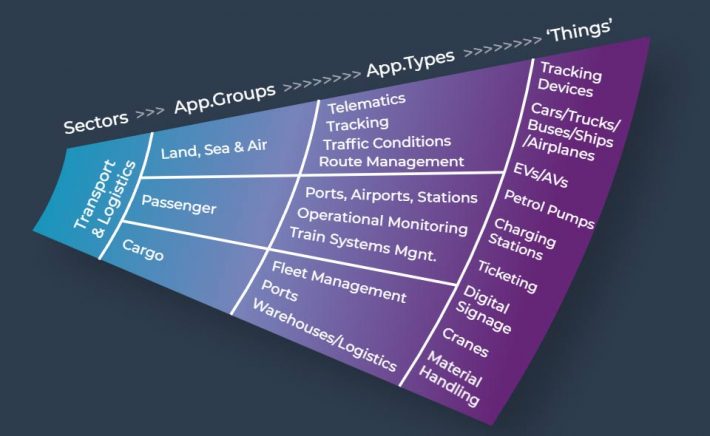Analyst Insights on the Transport and Logistics sector
Within the World of IoT Map, the Transport and Logistics sector is the longest-established and largest IoT sector and will continue to be the fastest-growing in terms of number of network connections. Connected Transport is also evolving more rapidly than many other IoT sectors.
As an example, fleet management of commercial vehicles, in particular heavy goods vehicles, is a continually-evolving application with many variations that has been a significant factor in the IoT market for over 20 years. The introduction of connected cars is now growing quickly and is already the largest single element of the sector. It will accelerate further as 5G cellular networks are rolled out and the market moves towards semi-autonomous and subsequently fully-autonomous vehicles.
The Transport sector covers all forms of mobile transportation – including road and off-road vehicles, ships, trains and all forms of flight – as well as transport infrastructure such as ports, airports, bus and rail stations, railways and roads. Road infrastructure includes street lights, traffic signals, traffic cameras and freight scanners for logistics purposes. While all forms of mobile transportation are dominated by wireless connectivity, this is most often in the form of cellular networks where there is coverage since this offers high speed roaming capability.
SIM, eSIM, dual eSIM
About 30 years ago SIM development started in the automotive sector. Initially, people wanted to connect vehicles for telematics services, and then for the mandatory eCall emergency services in Europe and the US. It was clear you couldn’t use a pluggable plastic card in a vehicle that might be on the road for 15-20 years, because dust, moisture, and vibration might compromise the connection. The obvious alternative was to solder the SIM in the car, but that didn’t address what happened when the vehicle was sold, so car makers turned to SIM providers for remote SIM management capabilities. Pre-standard solutions were developed in 2013 and later standardised by the GSMA.
There are continuing developments in this sector. A leading Europe-based SIM provider is now launching a dual connection solution with a well-known Bavarian car manufacturer. It’s a dual eSIM, supporting vehicle telematics to updating your navigation system, control your battery status, and report your vehicle service status to the car maker. You also have another connection to the vehicle for entertainment services such as Apple Music, Spotify or Netflix and this can make use of the driver’s existing data plan that may not be fully utilising their monthly data plan.
Growing role for satellite connectivity
Where cellular network coverage is not feasible, satellite is in demand for remote regions in the 80% of the earth’s surface not covered by cellular networks. In fact, with satellite pricing becoming more competitive there is increasing opportunity for satellite use in less remote regions over the next few years. For more than a decade, dual mode operation of cellular/satellite has been used for long distance heavy goods vehicles as well as for shipping and containers.
Ports automate with IoT
The Internet of Things is playing a key role in port automation to drive down cargo handling and cut delayed shipments. Port operators have 3 key objectives; improving efficiency to boost the bottom line, competitiveness to drive more traffic, and sustainability to curb emissions. The data volumes from assets moving through the port are huge, many devices are mobile, and some data is required in real time, so deploying the right wireless technologies is critical for the network to be secure, cost-effective and reliable.
For example, 5G NR (New Radio) is the standard for 5G networks worldwide. 5G NR-U, which was finalised in 2020 as part of the 3GPP standard in Release 16, enables 5G NR to operate in unlicensed spectrum. Users say it offers 5G’s high performance and security, yet is simple and affordable.
Edge processing
As data created within vehicles increases, there is a now stronger need for use of on-board edge processing so that data collected can be pre-processed and used for local control, before sending to the cloud for other complementary applications.
Fixed infrastructure, for example shipping ports, are now being required to introduce higher levels of automation to increase productivity while reducing costs. Private cellular networks using 4G and subsequently 5G technology provide a means of achieving this.
IoT for electric vehicle charging
Estimates vary, but battery electric vehicles (BEVs) are forecast to represent 20% of all vehicles on Europe’s roads by 2025, albeit with a slightly lower total in North America. These are not just private vehicles, but also enterprise fleets, light commercial vehicles, coaches and taxis. This can be a form of home charging, charging at business locations or charging posts in public places.
One of the primary objections to EVs is Range Anxiety, the fear that a vehicle has insufficient charge to reach its destination. Overcoming this will depend on increased charging at home or at work, locations, but a greater degree of confidence in the availability of public charging sites.
EU recommendations are for 1 public charging post for every 10 BEVs on the road. Beecham’s research suggests that while some countries are currently exceeding this recommendation, many are far behind, with charging locations unevenly distributed. IoT is enabling charging operators to have a real-time view of their charging estate, cutting downtime, dwell time, authorisation delays, engineer truck rolls, while increasing revenues, and improving public confidence in BEVs as an alternative to their existing internal combustion engine cars.
IoT data informs vehicle design
Finally, data is central to automotive development – a future of self-driving cars, electric vehicles and connected infrastructure. BlackBerry has identified 7 areas of innovation that are key key to transforming mobility They are: Customer care, In-vehicle applications, Electric cars, Ubiquitous data, On-demand mobility, Securing your cyber defence, and Driverless cars.
You will find expert partners and more information on all the above topics through The World of IoT Map










